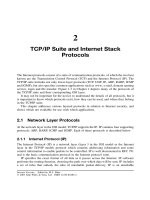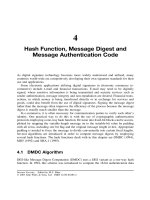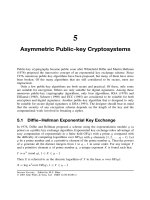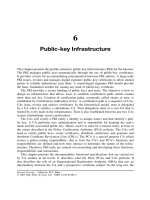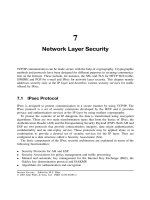Distributed Algorithms and Protocols for Scalable Internet Telephony
Bạn đang xem bản rút gọn của tài liệu. Xem và tải ngay bản đầy đủ của tài liệu tại đây (1.18 MB, 358 trang )
Distributed Algorithms and Protocols for Scalable Internet
Telephony
Jonathan Rosenberg
Submitted in partial fulfillment of the
requirements for the degree
of Doctor of Philosophy
in the Graduate School of Arts and Sciences
COLUMBIA UNIVERSITY
2001
c
2001
Jonathan Rosenberg
All Rights Reserved
ABSTRACT
Distributed Algorithms and Protocols for Scalable Internet
Telephony
Jonathan Rosenberg
Internet telephony service is defined as the provision of real-time, interactive, multimedia telecom-
munications services between human users, using the public Internet.
The most difficult problem in providing Internet telephony is to overcome the increased
jitter, delay, and loss (as compared to circuit-switched networks) suffered by voice. Past work
has separately investigated Forward Error Correction (FEC) and playout buffer adaptation mech-
anisms to resolve these problems. We show that these mechanisms must be considered jointly. We
propose and simulate a number of algorithms for integrating FEC into playout buffer adaptation
schemes, and show that they are superior to non-integrated algorithms.
Receiving feedback about network transport quality is essential for supporting adaptive
applications. We examine the issues surrounding scalability of transport feedback in large scale
multicast groups. We present, analyze, and simulate a class of algorithms termed reconsideration,
which support congestion controlled feedback in highly dynamic groups, and then show how the
memory requirements of our algorithms can be reduced.
We consider signaling protocols for providing call establishment, management, features,
and applications. After an analysis of existing Internet telephony signaling protocols, we propose
a new protocol, the Session Initiation Protocol (SIP), which overcomes the limitations of existing
protocols. We describe an implementation of this protocol in software, and discuss applications
we have built with it.
We consider interconnection with the telephone network, and focus on the problem of
discovery of telephony gateways. We show that this is a subset of a broader wide area service
discovery problem. After reviewing existing protocols for resource discovery (and finding them
lacking for wide area applications), we present a scalable protocol for wide area service discovery,
which is ideal for discovery of gateways, amongst other resources.
Finally, we consider the problem of a service architecture for Internet telephony, which
provides features and complex applications to users. We review the service architectures that have
been presented in the literature. We then propose our architecture, the application component
architecture, which combines the best aspects of existing work. We show how this architecture
can be used to provide several complex applications.
Contents
List of Tables x
List of Figures xi
Acknowledgments xv
Chapter 1 Introduction 1
1.1 Components of an Internet Telephony Service . . ................. 2
1.1.1 Organization ................................ 3
Chapter 2 Transport 5
2.1 Introduction ..................................... 5
2.2 Internet Measurements . . . ............................ 6
2.2.1 Previous Work . . . ............................ 6
2.2.2 Measurement Approach .......................... 8
2.2.3 Results for Receivers ............................ 11
2.2.4 Results for Senders . ............................ 17
2.2.5 Conclusions ................................. 23
2.3 Review of Existing Recovery Mechanisms ..................... 23
2.4 Media Aware vs. Media Unaware Recovery . . . ................. 25
2.4.1 Resynchronization Time .......................... 26
2.4.2 Magnitude of Error . ............................ 29
2.4.2.1 Objective Measurements . . . ................. 29
i
2.4.2.2 Subjective Measurements . . . ................. 31
2.4.3 Contribution of Resynchronization ..................... 32
2.4.3.1 Objective Comparison ...................... 33
2.4.3.2 Subjective Tests . . . ...................... 34
2.5 Integrating FEC with Playout Buffers . ...................... 34
2.5.1 The Coupling Effect ............................ 36
2.5.1.1 Redundant Codecs . . ...................... 37
2.5.1.2 Reed-Solomon FEC . ...................... 38
2.5.1.3 Conditions for Dependency . . ................. 40
2.5.1.4 A Note on Applicability..................... 41
2.5.2 Existing Playout Buffer Algorithms . . . ................. 41
2.5.3 New Playout Buffer Algorithms ...................... 43
2.5.3.1 Virtual Delay Algorithms . . . ................. 44
2.5.3.1.1 Formulation for Redundant Codecs .......... 44
2.5.3.1.2 Formulation for Reed Solomon FEC . . . ...... 45
2.5.3.1.3 Implementation . . . ................. 45
2.5.3.1.4 Proof of Correctness ................. 45
2.5.3.1.5 Supporting Target Loss Probabilities . . . ...... 48
2.5.3.2 “Previous Optimal” Algorithm ................. 50
2.5.3.3 Model-Based “Analytical” Playout Adaptation Algorithm . . . 52
2.5.4 Simulations ................................. 56
2.5.4.1 Simulation Model . . ...................... 56
2.5.4.2 Coupled vs. Uncoupled ..................... 57
2.5.4.3 Comparisons of New Algorithms ................ 62
2.5.4.3.1 Using FEC with Minimal Delays ........... 62
2.5.4.3.2 Achieving a Specific Loss Target ........... 64
2.5.4.3.3 Achieving a Varying Loss Target ........... 64
2.6 Transport of Media-Unaware FEC . . . ...................... 67
2.6.1 Transport Requirements .......................... 68
ii
2.6.2 Previous Work . . . ............................ 68
2.6.3 Our Approach ................................ 70
2.6.3.1 Overview ............................ 70
2.6.3.2 Details . . ............................ 71
2.6.3.2.1 FEC Packet Structure ................. 71
2.6.3.2.1.1 RTP Header of FEC Packets . . . ...... 71
2.6.3.2.1.2 FEC Header . ................. 72
2.6.3.2.2 Protection Operation ................. 73
2.6.3.2.3 Reconstruction . . . ................. 74
2.6.4 Determination of the Set of Packets . . . ................. 75
2.6.4.1 Reduction ............................ 76
2.6.4.2 Computing T .......................... 77
2.7 Conclusion and Future Work ............................ 79
Chapter 3 QoS Feedback 81
3.1 Introduction ..................................... 81
3.2 Overview of RTP . ................................. 83
3.2.1 RTCP: Control and Management ...................... 84
3.2.2 Scaling RTP ................................ 85
3.3 Problems with RTCP Feedback ........................... 87
3.3.1 Congestion ................................. 88
3.3.2 State Storage ................................ 89
3.3.3 Delay . . . ................................. 89
3.4 Requirements of a Solution for IP telephony . . . ................. 89
3.5 Taxonomizing the Solution Space . . . ...................... 90
3.5.1 Feedback Destination: Where . ...................... 90
3.5.2 Feedback Mechanism: How . . ...................... 91
3.5.3 Feedback Source: Who ........................... 92
3.5.4 Feedback Content: What .......................... 93
3.5.5 Congestion Control: When . . . ...................... 93
iii
3.6 Solution Space . . ................................. 94
3.6.1 Existing Solutions . ............................ 95
3.6.1.1 Summarizers ........................... 95
3.6.1.2 Polling . . ............................ 96
3.6.1.3 Separate Multicast Groups . . ................. 97
3.6.1.4 Event-Based Reporting ..................... 98
3.6.2 Additional Approaches ........................... 99
3.7 Reconsideration Algorithm . ............................100
3.7.1 Ideal Behavior . . . ............................104
3.7.2 Simulations .................................105
3.7.3 Analysis . ................................. 110
3.7.3.1 No Delay . ............................111
3.7.3.1.1 Computing the Send Probability ...........112
3.7.3.1.2 Computing the Scheduled Rate . ...........113
3.7.3.1.3 Obtaining the ODE . ................. 117
3.7.3.1.4 Computing the Level of Congestion . . . ......117
3.7.3.1.5 Reconsideration as a Control Mechanism . ......119
3.7.3.1.6 Computing the Convergence Time ..........120
3.7.3.2 Modeling Delay and Loss . . . ................. 120
3.7.3.2.1 Number of Packets Sent for Conditional Reconsider-
ation ..........................122
3.7.3.2.2 Number of Packets Sent for Unconditional Reconsid-
eration.........................124
3.7.3.2.3 Duration of Plateau Period . . . ...........125
3.7.3.3 Linear Joins ...........................126
3.7.3.4 Steady State Behavior ......................130
3.7.3.5 Fairness . ............................134
3.7.3.6 Single User Joins Late ......................135
3.8 BYE Reconsideration Algorithm ..........................137
iv
3.9 Reverse Reconsideration . . ............................140
3.9.1 Quantifying the Problem ..........................141
3.9.1.1 Long Declines ..........................143
3.9.1.2 Rapid Declines ..........................144
3.9.2 Reverse Reconsideration Algorithm . . . ................. 145
3.9.3 Performance ................................148
3.10 Group Sampling . . .................................149
3.10.1 Basic Operation . . . ............................150
3.10.1.1 Performance ...........................151
3.10.2 Increasing the Sampling Probability . . . .................152
3.10.3 Reducing the Sampling Probability . . . .................152
3.10.3.1 Corrective Factors . . ......................153
3.10.3.2 Binning Algorithm . . ......................155
3.10.3.3 Comparison ...........................156
3.10.4 Sender Sampling . . ............................157
3.11 Conclusions .....................................158
Chapter 4 Signaling Protocols 160
4.1 Introduction .....................................160
4.2 Requirements for a Signaling Protocol . ......................161
4.3 Existing Signaling Protocols ............................163
4.3.1 BICC . . . .................................164
4.3.2 H.323 . . . ................................. 164
4.4 SIP Overview . . . ................................. 166
4.4.1 Protocol Components ............................167
4.4.2 SIP Network Servers ............................168
4.4.3 SIP Messages ................................ 171
4.4.4 Addressing and Naming ..........................172
4.4.5 Initiating, Modifying, and Terminating Calls ............... 173
4.4.6 Registrations ................................174
v
4.4.7 Session Description Protocol Usage . . . .................175
4.4.8 SIP as a Tool for New Services . ......................177
4.4.8.1 MIME . . ............................177
4.4.8.2 URIs . . . ............................179
4.5 Implementation . . .................................179
4.5.1 Events and Threading ...........................180
4.5.2 Processing Architecture ..........................182
4.5.3 Server State Machine ............................185
4.5.4 Client State Machine ............................188
4.5.5 Mediator State Machine ..........................190
4.5.6 Server API .................................193
4.5.7 Memory Management ...........................194
4.5.8 Services . . .................................195
4.6 Conclusions and Future Work ............................196
Chapter 5 Gateway and Service Discovery 198
5.1 Introduction .....................................198
5.2 Problem Definition .................................199
5.2.1 Gateways . .................................199
5.2.2 General Services . . ............................204
5.3 Related Work . . . ................................. 208
5.4 Existing Solutions . .................................209
5.4.1 Centralized Databases ...........................210
5.4.1.1 Service Location Protocol . . . .................211
5.4.1.2 Discussion ............................212
5.4.2 Replicated Databases ............................213
5.4.3 Distributed Databases ...........................214
5.4.3.1 DNS . . . ............................214
5.4.3.2 LDAP and X.500 . . ......................216
5.4.4 Indexed Databases . ............................217
vi
5.4.4.1 Telephony Routing over IP (TRIP) ...............219
5.4.4.2 Discussion ............................222
5.4.5 Multicast Push and Pull ..........................223
5.4.6 Summary of Existing Architectures . . . ................. 224
5.5 Wide Area Service Discovery Protocol . ......................225
5.5.1 Terms . . . .................................226
5.5.2 Basic Operation . . . ............................227
5.5.3 BA URL’s and Attributes ..........................229
5.5.4 Message Formats . . ............................230
5.5.5 SA Behavior ................................230
5.5.6 DA Behavior ................................ 232
5.5.6.1 Multicast Listening . ......................233
5.5.6.2 Contacting BA’s . . . ......................233
5.5.6.3 Multicasting DAAdverts ....................235
5.5.7 AA Behavior ................................235
5.5.8 BA Behavior ................................236
5.5.8.1 Receiving Advertisements . . . .................236
5.5.8.2 Policy . . ............................236
5.5.8.3 Policing . ............................237
5.5.9 Sending Multicast Advertisements .....................237
5.5.10 Scheduling Transmission of Advertisements ................238
5.5.10.1 Timing Out Senders . ......................239
5.5.10.2 Minimum Transmission Interval ................ 240
5.5.11 Multicast Groups . . ............................240
5.5.12 Reducing the Storage Requirements of a BA ...............240
5.6 Conclusion .....................................241
Chapter 6 Application Architecture 242
6.1 Introduction .....................................242
6.2 Requirements for an Internet Telephony Service Architecture ...........243
vii
6.3 Existing Architectures . . . ............................246
6.3.1 Centralized Architectures ..........................246
6.3.1.1 Intelligent Network . ......................246
6.3.1.2 MGCP . . ............................249
6.3.2 Distributed Software Architectures .....................250
6.3.3 Distributed Component Architectures . . ................. 253
6.3.4 Mobile Agents . . . ............................256
6.3.4.1 General Purpose Languages . . ................. 256
6.3.4.2 Domain Specific Languages . . .................257
6.4 Application Component Architecture . . ......................258
6.4.1 Dialog Component . ............................263
6.4.2 Mixing Component . ............................268
6.4.3 Text-To-Speech Component . . ......................270
6.4.4 Additional Session Components ......................271
6.4.5 Presence Component ............................272
6.4.6 Additional Components ..........................275
6.4.7 Controller . .................................276
6.4.8 Third Party Call Control ..........................278
6.4.8.1 Basic Flow ............................279
6.4.8.2 Advanced Flow . . . ......................280
6.4.8.3 Continued Processing of Third Party Calls ...........281
6.4.8.4 End User Initiates Call ......................283
6.4.9 Obtaining Data from End Users ......................284
6.4.9.1 Stimulus Signaling . . ......................286
6.4.9.2 Functional Signaling . ......................288
6.5 Target Services . . .................................289
6.5.1 Pre-Paid Calling Card ...........................290
6.5.2 Click-to-dial ................................291
6.5.3 Auto-conference . . ............................293
viii
6.5.4 Web Form Entry for Call Center ......................297
6.5.5 Speech-to-text for the Hearing Impaired . ................. 298
6.6 Comparison to Existing Architectures . ......................300
6.6.1 DFC and ECLIPSE . ............................300
6.6.2 Distributed Software and Component Architectures . ...........301
6.6.3 Mobile Agents . . . ............................303
6.6.4 Centralized Architectures ..........................303
6.7 Conclusions and Future Work ............................303
Chapter 7 Conclusion and Future Work 305
ix
List of Tables
2.1 Locations of stations ................................ 9
2.2 Statistics of Traces ................................. 10
2.3 Resynchronization Time vs. Burst Length ..................... 29
2.4 MSE vs. Burst Length . . . ............................ 30
2.5 Subjective Evaluation of Speech Quality ...................... 31
2.6 Avg. and SD of MSE for mix1 and mix2 ...................... 33
3.1 Operating Point of Summarizers in the Feedback Taxonomy ........... 97
3.2 Operating Point of Polling in the Feedback Taxonomy ............... 97
3.3 Operating Point of Separate Multicast Groups in the Feedback Taxonomy .... 98
3.4 Operating Point of Event Based Reporting in the Feedback Taxonomy ...... 99
3.5 Transient Behavior for Various Group Sizes . . . .................126
3.6 Group Size Estimate with Sampling Algorithms . ................. 157
x
List of Figures
2.1 Measurement setup ................................. 9
2.2 Mean loss probability for trace 1 .......................... 12
2.3 Mean loss probability for trace 2 .......................... 12
2.4 Mean loss probability for trace 3 .......................... 13
2.5 Conditional loss probability for trace 1 . ...................... 14
2.6 Conditional loss probability for trace 2 . ...................... 14
2.7 Conditional loss probability for trace 3 . ...................... 15
2.8 Burst loss length distribution for trace 1 ...................... 16
2.9 Burst loss length distribution for trace 2 ...................... 16
2.10 Burst loss length distribution for trace 3 ...................... 17
2.11 Cumulative distribution of delay increase from playout buffers for trace 1 .... 18
2.12 Cumulative distribution of delay increase from playout buffers for trace 2 .... 18
2.13 Cumulative distribution of delay increase from playout buffers for trace 3 .... 19
2.14 RTT delay distribution, Columbia to U.Mass . . . ................. 20
2.15 RTT delay distribution, Columbia to USC ..................... 20
2.16 RTT delay distribution, Columbia to Germany . . ................. 21
2.17 Evolution of RTT, Columbia to U. Mass ...................... 21
2.18 Evolution of RTT, Columbia to USC . . ...................... 22
2.19 Evolution of RTT, Columbia to Germany ...................... 22
2.20 Cumulative distribution of resynchronization times ................ 28
2.21 Cumulative distribution of avg. MSE . . ...................... 30
xi
2.22 Mix1 and mix2 . . ................................. 33
2.23 Preferences for mix1, mix2, or neither . ...................... 35
2.24 Piggybacking FEC packets for a (5, 3) Reed Solomon code . ........... 39
2.25 Performance of Adaptively Virtual Algorithms on Trace 2 . . ........... 58
2.26 Performance of Adaptively Virtual Algorithms on Trace 1 . . ........... 60
2.27 Performance of Adaptively Virtual Algorithms on Trace 3 . . ........... 61
2.28 Comparison of Loss and Delay Performance across All Algorithms . . ...... 63
2.29 Performance of Algorithms in Achieving a Target Loss of 0.07 .......... 65
2.30 Performance of Algorithms in Achieving Varying Target Loss Probability .... 66
2.31 FEC packet structure ................................ 71
2.32 Parity header format ................................ 72
3.1 RTP fixed header format . . ............................ 83
3.2 Current RTCP Algorithm . . ............................ 87
3.3 Conditional Reconsideration ............................102
3.4 Unconditional Reconsideration ...........................103
3.5 Network Model . . ................................. 106
3.6 Learning curve, step join with N=10,000 .....................107
3.7 Total packets sent, step join with N=10,000 . . . .................107
3.8 Effect of delay distribution on transient for conditional reconsideration ......109
3.9 Linear joins: conditional reconsideration ......................110
3.10 Linear joins: unconditional reconsideration . . . .................110
3.11 Computing P
send
with reconsideration . ......................113
3.12 Experimental vs. Analytical Scheduled Rate Integral ............... 116
3.13 Experimental vs. analytical learning curve .....................118
3.14 L(t) vs.
r(t) ....................................119
3.15 Transient with Conditional Reconsideration . . . .................124
3.16 Transient with Unconditional Reconsideration . . ................. 125
3.17 Steady State RTCP Packet Rate ...........................131
3.18 Oscillating Steady State RTCP Packet Rate . . . ................. 134
xii
3.19 Coefficient of Variation of Packets Transmitted . ................. 135
3.20 BYE Reconsideration Performance . . . ......................140
3.21 Premature Timeout Problem ............................141
3.22 Reverse Reconsideration Algorithm . . ......................148
3.23 Group Size Estimate with Reverse Reconsideration ................149
3.24 Comparison of SSRC Sampling Algorithms . . . .................156
4.1 Typical SIP deployment . . . ............................170
4.2 Typical SIP INVITE message ............................171
4.3 SDP message example . . . ............................176
4.4 gosSIP threading architecture ............................181
4.5 gosSIP state machine architecture . . . ......................184
4.6 Example CPL+ script ................................ 186
5.1 Architecture for TRIP ................................220
5.2 Customer X uses gateway through bilateral provider relationships . . ......221
5.3 Worst and best case topologies for indexed database query times . . . ......223
5.4 WASRV architecture ................................227
5.5 SA state machine . .................................232
6.1 IN conceptual model ................................ 247
6.2 Call flow for a phone call . . ............................248
6.3 A usage in the DFC architecture ..........................255
6.4 Application component architecture . . ......................260
6.5 Client interaction with dialog server for PIN collection . . . ...........267
6.6 Message exchange for basic presence service . . ................. 274
6.7 Call flow for interface to message component . . ................. 275
6.8 Interface between the controller and session components . . ...........277
6.9 Signaling and media relationships in third party call control . ...........278
6.10 3pcc basic flow . . .................................279
6.11 3pcc advanced flow ................................. 280
xiii
6.12 Hanging up with 3pcc ................................282
6.13 Alternative to hangup ................................ 282
6.14 3pcc where the end user initiates ..........................283
6.15 Using HTTP as a stimulus protocol . . . ......................287
6.16 Pre-Paid calling card service ............................290
6.17 Click-to-dial service ................................. 292
6.18 First half of auto-conference service . . ......................294
6.19 Call establishment phase of auto-conference . . . ................. 296
6.20 Call flow for web form entry for call center . . . .................297
6.21 Bidirectional translation services for the hearing impaired . . ...........299
xiv
xv
Acknowledgments
First and foremost, Professor Henning Schulzrinne deserves recognition for his tremendous con-
tributions to this work, in addition to recognition for the immeasurable impact he has had on
my career and professional development. Professor Schulzrinne provided guidance, knowledge,
insight and direction whenever it was needed. He introduced me to many of the pioneers in the
Internet, giving me an opportunity to learn from them as well. He introduced me to the Internet
Engineering Task Force (IETF), a professional organization through which much of this work has
found a commercial outlet. I will be forever in his debt.
Several other individuals deserve special recognition for their impact on this thesis.
Lili Qiu deserves recognition as a key contributor of much of the work in transport chap-
ter. She prepared many of the simulations and the plots used in the section on playout buffer
integration. She was also responsible for the fine tuning of parameters that took place for many
of the algorithms. She contributed the idea of the previous optimal algorithm, and helped refine
the formulation for the analytical algorithm.
The taxonomy for feedback presented in the feedback section was the result of joint work
with Joerg Nonnenmacher and Markus Hoffman from Bell Laboratories. Daniel Rubenstein de-
serves complete credit for the proof of the steady-state unconditional reconsideration rate. The
initial concept of reconsideration (which we now call conditional reconsideration) was proposed
by Henning Schulzrinne. The original concept of SSRC sampling was proposed by Steve Casner.
Much of this work has been reviewed and commented on by members of the AVT working group
in IETF, and in particular, Steve Casner, Colin Perkins and Bill Fenner.
The work on generating requirements for the general service discovery problem was done
jointly with Erik Guttman from SUN Microsystems and Ryan Moats from AT&T Labs. Dave
Oran from Cisco deserves credit for first recognizing that the bilateral model is nearly identical to
the BGP4 model. Erik Guttman provided many comments on the WASRV protocol which made
their way into this thesis. Dina Katabi contributed many ideas and thoughts on performance for
WASRV.
Mark Handley (ACIRI), Henning Schulzrinne and Eve Schooler (Caltech) deserve recog-
nition for the initial work on SIP. Pete Mataga from dynamicsoft contributed to many of the ideas
on the component architecture for SIP, along with assistance in defining some of the combined
services presented here. Jon Peterson from Level(3) and Gonzalo Camarillo from Ericcson pro-
vided helpful and valuable input on third party call control.
The implementation of the ACA is ongoing work at dynamicsoft, where I am currently
employed. Many software engineers deserve credit for the long nights involved in realizing the
controller described in this dissertation, and development of applications using this architecture.
They include Peter Mataga, Prasad Sripathi, Edgar Villanueva, John Eichelsdorfer, Srinivas Ma-
ganti, Srinivas Dharmaji, Andrew McGrath, Kevin Grey, Ajay Deo, Kelvin Porter, Ed Gokhman,
Xin Feng, David Ladd, and Anders Kristensen. Additional thanks to Eric Burger from Snowshore
Networks, and Ed Yackey from Voyant, for their comments and support of this architecture.
Last but not least, I would like to thank my wife Michelle, and son Joshua, for providing
encouragement and understanding throughout my educational career.
xvi
This thesis is dedicated to Michelle and Joshua, for their support and understanding.
xvii
1
Chapter 1
Introduction
The problem of carrying voice on IP-based packet networks was first identified by Cohen et al.
[1] in 1977. Much of Cohen’s work, and the work that followed, focused on recovering from the
lower quality offered by packet networks (asynchronous delivery, high packet loss rates, high la-
tencies, substantial packet jitter) as compared to circuit-switched networks. Of particular interest
was recovery from packet jitter through the use of receiver jitter buffers, and loss compensation
techniques to handle packet loss. However, as usage of IP networks for multimedia delivery in-
creased, the community began to realize that the delivery of multimedia communications services
over IP networks was a much broader, and much more difficult problem.
The problem is more difficult because the actual transport of multimedia from point A
to point B is only a small piece of an overall multimedia communications service. Signaling
protocols are needed to establish and maintain calls. Features need to be defined and architected.
Multiparty conferences, ranging from three people to millions of people, need to be considered.
Interoperability with the legacy Public Switched Telephone Network (PSTN) needs to be con-
sidered. Quality must be provided, not just for the media itself, but for the service overall. All
of these, taken together, are needed to provide a complete Internet telephony service. As a re-
sult, we define Internet telephony service as the provision of real-time, interactive, multimedia
telecommunications services between human users, using the public Internet.
2
1.1 Components of an Internet Telephony Service
Many systems need to be designed and developed to provide a complete Internet telephony ser-
vice, as defined above. We can identify at least five that have been considered to date:
Transport: The system that carries voice and video between two points on an IP network. The
transport system is responsible for handling packet loss, packet jitter, and delay. On the
Internet, voice and video transport are provided by the Real-Time Transport Protocol (RTP)
[2].
Transport Control: The system that manages and controls the behavior of the transport algo-
rithms and protocols. It provides feedback to senders (and third parties) on the loss, delay,
and jitter being provided by the transport network. On the Internet, this is provided by the
Real Time Control Protocol (RTCP) [2].
Call Signaling: The system that sets up, tears down, and manages the multimedia calls which
make use of the underlying transport and transport control systems.
Applications: The system which provides Internet telephony features and applications to users.
Examples of these include call forwarding, transfer, conferencing, personal assistant, and
pre-paid calling cards. The application system makes extensive use of signaling protocols.
Resource Discovery: The system that allows for the discovery of network servers, such as gate-
ways, feature servers, bridges, and media servers, which are used by the signaling and
services system to provide call control and features.
Other components, such as management systems, are also important for Internet tele-
phony. However, we have chosen to focus on these five above, since we feel they represent the
core of an Internet telephony service.
In this thesis, we investigate the problems of providing a complete Internet telephony
service, focusing on the differences between IP networks and circuit switched networks, and
their implications on providing the service.
3
1.1.1 Organization
This dissertation is divided into five main chapters, with each focusing on problems in each of
the five components we describe above. Rather than reviewing existing literature up front, we
distribute the review in each chapter.
The first chapter, on transport, more clearly defines the implications of the Internet on
voice quality through measurements we have taken and analyzed. Our analysis focuses on the
voice quality observed by the user after recovery algorithms have been applied, and demon-
strates that media-unaware Forward Error Correction (FEC) has advantages over media-aware
FEC when used with low-rate codecs. After reviewing past work on addressing the quality prob-
lems, we identify a new problem introduced by an interaction between two existing mechanisms,
namely playout buffer adaptation and FEC. We analyze the problem and propose new classes of
playout buffer algorithms that take this interaction into account, and then demonstrate the im-
provement in performance they provide. We propose a new protocol for carrying FEC within
RTP, and we describe a novel algorithm that allows a receiver to utilize a large class of FEC
codes.
The second chapter considers transport control. It introduces three problems we have
discovered in the existing RTCP control mechanisms, which are congestion, state storage, and
delay. We examine the possible set of solutions proposed elsewhere in the literature, aided by a
taxonomy we developed for this purpose. We conclude that the ideal solution is one that provides
backwards compatible improvements to the existing RTCP mechanisms. We then propose a set of
new RTCP control algorithms called reconsideration, which can eliminate the RTCP congestion
problems. We develop analytical models for the reconsideration algorithms, and through these
models, demonstrate the existence of the congestion problem and the performance of our solu-
tions. We back up the analysis with simulations, using a simulator we constructed. To resolve
the state storage problems, we propose an algorithm for dynamic sampling which can reduce the
memory requirements of systems in large conferences, with little impact on performance. We
demonstrate these claims with simulations and analysis.
The third chapter considers signaling protocols for providing call establishment, call man-
agement, features, and applications. After an analysis of existing Internet telephony signaling
4
protocols, we propose a new protocol, the Session Initiation Protocol (SIP), which overcomes the
limitations of existing protocols. We describe an implementation of this protocol in software, and
discuss applications we have built with it.
The fourth chapter considers resource discovery. We define the problem of Internet tele-
phony gateway discovery, required for interconnection with the telephone network. We show that
this is a subset of a broader wide area service discovery problem. After reviewing existing pro-
tocols for resource discovery (and finding them lacking for wide area applications), we present a
scalable protocol for wide area service discovery, called the Wide Area Service Discovery Proto-
col which is ideal for discovery of gateways, amongst other resources.
The fifth chapter considers a service architecture for Internet telephony, which provides
features and complex applications to users. We define requirements of a service architecture
for Internet telephony, and then review the service architectures that have been presented in the
literature. We then propose our architecture, the Application Component Architecture (ACA),
which combines the best aspects of existing work. We show how this architecture can be used to
provide several complex applications.
The final chapter concludes and reviews our findings.



